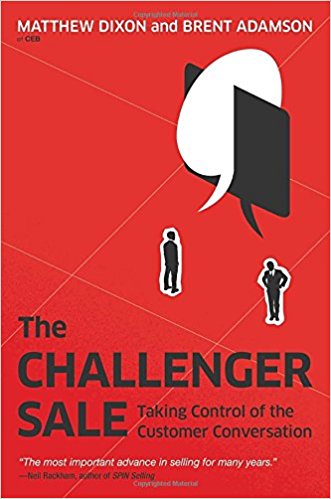The Challenger Sale DEFINITIVE Summary

14 min read ⌚

Taking Control of the Customer Conversation
If you’re in the business world long enough, you’re probably aware that the fundamental rule of sales success is simple: the customer is always right. Consequently, the job of a salesperson is fairly simple as well: he or she needs to build a good relationship with the client.
But, what if this is only partially true?
Or even wrong?
What if there’s a new law in town, and what if that law is something you would not intuitively abide by?
This is exactly what Matthew Dixon and Brent Adamson claim in “The Challenger Sale.” And our job is, you know it – to summarize their main ideas in about 1,000 words.
So, let’s go.
Who Should Read “The Challenger Sale”? And Why?
“The Challenger Sale” is something quite unique. Namely, it’s a well-researched book which claims to have uncovered a better and more feasible way to sell your products.
Now, don’t forget that people have been buying and selling things since the dawn of times. Not only that, but successful businesses have followed the relationship builder model for long enough. And it works.
So, what new could be there to learn?
Read “The Challenger Sale” if you want an answer to this question. You’ll certainly get it. And if you are serious about a career in selling, as an Amazon review rightly states, don’t just read it. Reread it. It’s just too original and fact-based to ignore it.
About Matthew Dixon and Brent Adamson
Matthew Dixon is an American author and in-demand speaker, one of the world’s foremost experts on sales. He has obtained his Ph.D. from the Graduate School of Public and International Affairs and has worked as a Group Leader in CEB’s research and advisory division.
is an American author and in-demand speaker, one of the world’s foremost experts on sales. He has obtained his Ph.D. from the Graduate School of Public and International Affairs and has worked as a Group Leader in CEB’s research and advisory division.
In addition to “The Challenger Sale,” he has co-written two more books, “The Challenger Customer,” and “The Effortless Experience.”
 Brent Adamson is an American author and sales researcher. He has obtained an MBA from the University of Michigan’s Ross School of Business, and a Ph.D. in applied linguistics from the University of Texas. He has worked as the managing director of the Sales Executive Council of the CEB.
Brent Adamson is an American author and sales researcher. He has obtained an MBA from the University of Michigan’s Ross School of Business, and a Ph.D. in applied linguistics from the University of Texas. He has worked as the managing director of the Sales Executive Council of the CEB.
With Dixon, Adamson has co-authored both “The Challenger Sale,” and “The Challenger Customer.”
“The Challenger Sale Summary”
If you’re a sales professional, you probably know a thing or two about selling strategies. But, here’s one thing you don’t know!
No matter what you’re doing to sell your product, you are one of five different types of salespeople!
How do we know that?
Well, because in 2009, the Sales Executive Council (SEC) researched how the economic crisis affected the business-to-business (B2B) sales world and found out that all sales reps fit neatly into five different categories.
The first group represents the hard workers. Their name says it all: they work more than the others. They call more people, they actively engage in long conversations, they give out more proposals than anyone else in the company.
The second group are the relationship builders. They simply don’t need to call that many people. They are aware of the 80/20 rule, and they know who are their most important customers. And the relationship to these customers means everything to these salespeople.
The lone wolves constitute the third group of sales reps. They are self-confident and they have their own way to do business. There’s no easy way to manage a lone wolf. The reason why he or she still works for you is simple: in even though in an unconventional manner, they bring the money.
The fourth group are the reactive problem solvers. These are pretty similar to customer service reps. To them, the customer is not only always right, but the customer must always be content and happy.
Finally, we have the challengers of the book’s title. They are both respected researchers and outstanding orators. In other words, they learn everything they can about their customers and they use the insight to help… well, everybody.
Because they are sweet talkers they can influence their customers to buy whatever they’re selling. But, they don’t just wish to sell something; they also want to inspire their customers to maximize the benefit of whatever they’re selling.

The idea that a salesperson is a charismatic, stylish guy who does everything to please the customer has lasted for a long time. This argument is destroyed in this book which is one of our favorites in the sales category at 12min.
Authors Matthew Dixon and Brent Adamson explain that the modern seller achieves success in a very different way from what the popular imaginary tells us.
“The Challenging Sale,” explores the characteristics of an effective salesperson: do not be afraid to take control and close sales through teaching instead of persuasion.
The authors have done a survey of about 6000 sales professionals and have concluded that effective seller is challenging.
With this reading, you will quickly learn how to become a challenger and turn your team members into challengers as well. Shall we go?
THE 5 SALES PROFESSIONAL PROFILES
During the research conducted by the authors to understand what success means in sales in the current world, they found there are 5 traditional sales profiles. They are based on skills and behavior when dealing with customers.
Although the profiles are not exclusive, each seller has a predominant profile, and you should strive to discover yours. The profiles are:
- Relationship Builder: They focus on building strong customer relationship networks. They are generous enough on time dedicated, strive to meet all client needs and work hard to resolve any stress in the business process.
- Hard worker: This is the seller who arrives early, leaves later and always gives a last push at the end. They will make more calls and visits than any other on the team.
- Lone Wolf: They tend to have high self-confidence, often only doing things their way, not following the established process.
- Problem Solver: They are super-focused on details and can generate great customer trust. They always seek to quickly solve any obstacles in the implementation or execution of the project through follow-ups
- Challengers: Use all your understanding of the client’s business to direct your speech and control the conversation. They talk fearlessly about controversial points of view even if they are contrary to the customer’s opinion.
After evaluating more than 6,000 survey responses, it became clear that the most popular approach among high-performance marketers is the challenging approach, and it is here that we will delve into the next few lessons.
EFFECTIVE SELLERS CHALLENGE THEIR CUSTOMERS
Many companies refuse to challenge their customers, only worrying about leaving them in their comfort zones.
However, efficient vendors develop new ideas and create complex solutions. To ensure that your customers think outside the box, you need to make them uncomfortable.
Most salespeople try to avoid problems and do not like to make their customers uncomfortable, seeking to maintain a lasting relationship.
But this sales style is not efficient. Being super nice and just saying what the customer wants to hear is not the solution.
In a survey conducted in several companies that tracked sales teams, it was discovered that the top performers used this approach.
To succeed in sales, you need to get your customers to confront problems and make tough decisions.
A good way to see the importance of this is to think about your friendships. Some people try to be good friends by getting along with others: they avoid confrontation, accepting situations and adapting.
However, the friends who help you the most are usually those who confront you: they lead you to face your problems and are honest about your mistakes – and the same is true for sales. To help a customer, you cannot be afraid to get them out of their comfort zones.
After all, if you want them to accept your product or service, you need to make them recognize the size and urgency of the problems, as well as their ability to solve them.
Telling stories about other companies that have made similar mistakes is an effective way to achieve this.
Discover businesses that have paid dearly for making the same mistakes your customer is making, explain the errors and difficulties, and support your information with data that shows how much money they are losing.
Obviously, you should be respectful and empathetic during the process, but it is important not to make it easy for the client.
You need to firmly demonstrate that they have made a mistake or overlooked some issue that is disrupting business.
Showing them a problem they did not know, you not only encourage them to recognize the issue but also demonstrate your value and your ability to help.
GET VALUE FOR THE CUSTOMER AND DO NOT FOCUS ON THE PRICE
Fear of bothering customers causes many sellers to reduce prices quickly and rely heavily on discounts. However, you can maintain your price and keep customers by demonstrating how your services can bring value to their businesses.
One area where sellers are usually cautious is about the direct negotiation of a sale.
Sales representatives are very passive, believing they should avoid conflicts, out of fear. That means that the customer is the one who is controlling the sale and therefore setting the price.
The best sellers are those who resist this trend by refusing to accept a value lower than the initial price. If you do so, you will not only increase your profits but also strengthen your position, making it clear that you recognize your value and will not negotiate your price.
Of course, this is not always easy – you will need to deal with the discomfort before you complete the sale.
Luckily, some techniques can help you. Perhaps the most efficient is to control the negotiation narrative and keep discussions away from the ‘price’ issue.
Keep the conversation far from price and focus on the features and benefits of your product and service. With this, when you approach the subject price, the customer will consider the various other variables of your service.
Keeping the fixed price leaves many sellers worried about losing a sale. The seller must negotiate, explain the more complex variables of the product or service, so that the customer perceives the value of the services, helping to maintain its price and closing the deal.
BEFORE SELLING, LEARN ABOUT THE CUSTOMER’S BUSINESS
In the b2b (business-to-business) world, one of the best ways to persuade customers to buy from you is by demonstrating that you can provide useful information and support during the process.
Profound research lets you understand your customers’ business more than they do themselves, which brings you to original ideas that prove your value.
In the modern market, customers look for more than good products and excellent services: they want you to improve their business with your knowledge and ideas, which means you need to be very well informed.
Many sellers make mistakes, spending time in meetings and meetings to learn more about customers’ business and understand what problem they want to be solved.
However, this attitude is a waste of time and does not impress customers, after all, they want you to say things they still do not know.
Before meeting with your clients, you should learn more about their business.
You need not only be able to tell what they do not know but also to show them the points they did not consider exploring – presenting a new perspective on the market and the business.
That requires a fundamental shift in the role you play in meetings: you need to teach and not learn.
That’s the value you bring: teaching clients things they cannot learn without you, challenging current ideas and practices.
To do this, you need to start studying the companies and their markets before meeting with your customers.
As you study, you have to keep in mind some questions: is there any data that can change the client’s perception of your company?
Can any disclosure change the view of the market or the competitors? Finally, does the business have any problems that I can solve?
If you can answer yes to all of these questions, you can position yourself as the person who can answer your customers’ needs, and you are the ideal person to close a deal.
Learning about your clients’ company more than themselves puts you in a great negotiating position.
Learning everything before meetings help you present valuable ideas and observations for any sale, encouraging customers to buy from you.
“SHOW, DO NOT TELL”
Sellers have a reputation for being talkative.
Although there is no doubt that being able to speak confidently and persuasively is a beneficial skill, it may also work against you – especially if you do not know what you are going to say or when to speak.
So instead of bombarding your customers with company information at the beginning of your presentation, store information until you have caught their attention. You must show, not tell.
Many representatives begin their presentations with a description of their company and products, to capture the potential customer’s attention, highlighting their differentials as early as possible.
However, b2b sales studies across multiple markets have shown that most customers have little interest in differences between their potential suppliers and that most details about their companies are irrelevant to them unless they are already interested in working with you.
Instead of trying to tell your customers why your company is so good, show them. Begin your presentation by showing your detailed knowledge about the market, their business, and the obstacles they face.
Develop this part with an original observation about the roots of your problems, which will change their perception of the company itself.
By changing the way a customer perceives his/her own company, you change his/her perception of you, making them recognize your strengths and capabilities, showing that you are informed and effective.
Afterward, it’s time to start giving specific information about your company to convince customers that you have the skills, experience, and resources needed to deliver the proposed solutions.
The customer will then be paying attention to these details because you have made them relevant by demonstrating that you are a good choice to improve their business.
Instead of flooding potential customers with irrelevant information, begin your presentation by showing that you can offer them valuable and radical ideas.
Once you earn their respect, you will be able to discuss the details of your company to help close the deal.
CREATE SPECIFIC CONTENT FOR EVERY PERSON INVOLVED IN THE DECISION-MAKING PROCESS
No matter how good your presentation is, you will not be able to convince every decision maker of the company to which you want to sell. To maximize your chances of success, prepare individual presentations for each person who has a say in the decision.
Nowadays, business decisions about new purchases are made via consensus, and many members need to decide together on whether to buy a product or hire a service. Many sales representatives do not take this into account and only deliver the same rehearsed presentation to everyone.
However, even the best presentations may fail to convince everyone concerned. The answer is to abandon this single model and prepare different presentations for each person responsible for decision-making.
When you are researching your customers’ business, you need to think about how your findings affect different members of the company.
Regardless of your findings, understand who are the most concerned and affected, and work on these points in your presentation to them.
Not only does this help you tailor your presentation to the interests and concerns of your customers, but it also helps you understand who will be a natural ally and who you will need to be convinced to close the deal.
Ensuring that you have expert knowledge not only about the company but also who are the involved decision makers allows you to tailor your presentations to reflect your primary interests and concerns.
That helps you focus on all stakeholders more effectively and support the entire organization.
CREATE A SALES MENTORS CULTURE IN YOUR COMPANY
Changing a company’s sales approach can be difficult, especially if it works against ideas already entrenched in the business culture.
However, a vendor mentoring program with a strong manager can facilitate and help ensure that sales force are working the best they can and are satisfied within the company.
Sales skills are just like any other “talent”: they are learned and developed through years of practice. This process can be complicated, so a great manager is essential.
Sales managers play a variety of roles within a team, but perhaps the most important is the mentor position, especially when the team is changing its sales methods.
A good manager and mentor can help sellers develop their skills and learn new approaches.
However, more than that, they can help the company keep sellers who already use the new methods. Effective mentoring will help sales reps realize that they have given support and space to grow.
Many things contribute to making an effective mentoring session, but perhaps the most important is one of the simplest: separate mentoring from performance reviews and other management tasks.
Many managers ignore this and end up holding sessions where the salesperson is unable to develop and exploit the situation efficiently. A good way to prevent this from happening is to focus on the seller’s behavior and not the results.
Performance management is often defined by the seller’s sales history.
But for mentoring, you should focus on discussing the processes that have led to this history. Make the sessions a free space for interactions without judgments and for exploring new ideas and perspectives.
This gives participants (the tutor and the salesperson) the freedom to interact outside the usual manager-seller relationship, encouraging the development of their team and their transition to a new style of sales.
Mentoring is one of the most important tasks of a manager.
Cultivating a separate space for this allows you to guide your salesforce in a new approach and help the best to feel supported in their development, ensuring they remain loyal and satisfied.
Key Lessons from “The Challenger Sale”
1. If You’re a Sales Rep, You’re One of Five Types
2. Relationship Builders Are a Thing of the Past: Challengers, Welcome
3. Build an Effective Challenger Sales Model
If You’re a Sales Rep, You’re One of These Five Types
There are only five types of salespeople: hard workers, relationship builders, lone wolves, reactive problem solvers, and challengers.
The hard workers make more calls and send out more proposals than any other category. The relationship builders are all about strong customer relationship. The lone wolves follow their own set of rules and are unmanageable. The reactive problem solvers keep the customers happy at all times.
The challengers – well, let’s just say, that they work both for their company and for their customers.
Relationship Builders Are a Thing of the Past: Challengers, Welcome
Relationship builders are the center of the traditional sales model. After all, it’s only logical and intuitive that they are. After all, relationships are what businesses are built upon.
However, a wide-ranging 2009 study and over 6,000 analyzed salespeople have confirmed that the business world has changed. Challengers are consistently ranked as the sales reps who sell the most.
The cause of this, it seems, is the change in customers’ behavior. The world is too dynamic nowadays for lasting relationships. What customers need more than this are proactive sales professionals who are not merely into selling, but who want to challenge their way of thinking.
In short, people who’ll help them make the best decision.
Build an Effective Challenger Sales Model
There are three ways to start building an effective challenger sales model. First and foremost, you can identify the challengers in your company and build your business around them. Secondly, you can train the rest of your employees to be a bit more proactive. And, finally, you can scout around and hire new challengers.
Either way, look for the strategic storytellers who are interested in researching their customers’ habits and do not really conform to the usual call/send out habits.
Like this summary? We’d Like to invite you to download our free 12 min app, for more amazing summaries and audiobooks.
“The Challenger Sale” Quotes
You can’t be an effective Challenger if you’re not going to push your customers. Share on X Customers want to talk about their business, not your solution. Share on X Over half of customer loyalty is a result not of what you sell, but how you sell. Share on X In a world where findable business has all but vanished, Relationship Builders are doomed to fail. Share on X Challenger reps aren’t focused on what they are selling, but on what the person they’re speaking to is trying to accomplish. Share on XOur Critical Review
As we already mentioned, “The Challenger Sale” is an exceptional book. It’s not exactly an easy read. In fact, it’s written in a technical style which may deter general readers from finishing it. But, ultimately, it’s too original to expect it to be laidback and simple.
What’s the most interesting part about it is that it’s a nice amalgam of theory and practical advice, of research and applicability. And this makes for an exciting read, both for scholars and sales professionals. We are neither – and yet we had more than stimulating time reading “The Challenger Sale.”








